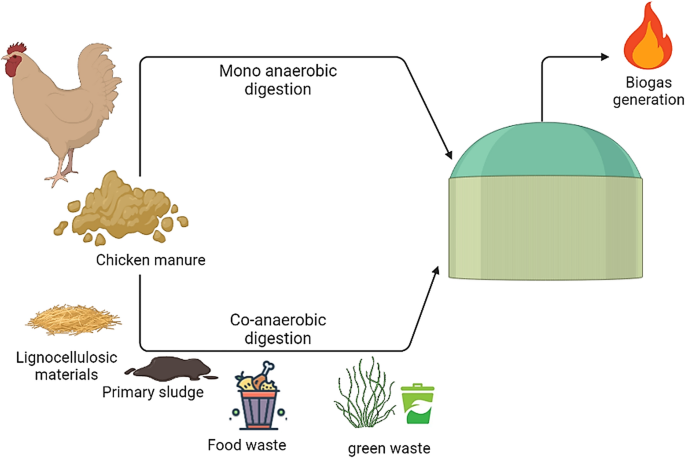Biogas from Poultry Waste - A Source of Energy - Market Overview and Future Demand

The global biogas market is witnessing a transformative surge, propelled by a convergence of factors such as the increasing focus on renewable energy, waste-to-energy initiatives, government support, and a growing emphasis on environmental sustainability. With technological advancements and rising awareness further accelerating market growth, the biogas sector is poised to play a pivotal role in the global energy landscape.
In 2020, the global biogas market reached a valuation of USD 24.03 billion, and projections indicate substantial growth, with the market expected to expand from USD 25.61 billion in 2021 to USD 37.02 billion by 2028, reflecting a commendable Compound Annual Growth Rate (CAGR) of 5.4% during the forecast period. Amidst a surge in demand driven by factors like government support, environmental concerns, and technological advancements, the industry is strategically positioning itself to capitalize on emerging opportunities.
With a growing interest in the economic viability of biogas, organizations are delving into financial and business concepts to navigate the industry's intricacies. Government investments are fostering private sector participation, with businesses keen on investing in new plants, driven by the promising economic foundation offered by biogas opportunities.
Biogas is a mixture of gases derived from various raw materials such as agricultural waste, manure, municipal waste, plant material, sewage, green waste, or food waste. Predominantly composed of carbon dioxide and methane, biogas also contains trace amounts of water vapors and supplied compounds. When burned in the presence of oxygen, biogas releases energy, which finds applications in electricity generation, cooking, transportation, and heating. The rising concerns about environmental safety and the increasing demand for clean energy are key drivers propelling market growth.
Market Driving Factors:
Expanding Opportunities in Emerging Markets:
Businesses in the biogas sector are eyeing development prospects in emerging nations where a significant portion of the population still relies on conventional firewood for household activities like cooking and heating. The desire to reduce dependence on fossil fuels, coupled with profitable opportunities in vehicle fuel applications, is propelling the industry forward.
Climate Change Preparedness:
Anticipating future incidents akin to the impact of COVID-19, the importance of biogas becomes even more pronounced in the context of climate change. Key industry players are leveraging this awareness, aligning with the evolving landscape of rapid demographic change, societal shifts, and technological advancements.
Circular Economy and Food Waste Management:
In response to the expanding circular economy trend, the food and beverage sectors are intensifying efforts to achieve a zero-waste economy. Biogas plays a pivotal role in this paradigm shift, with businesses redirecting food waste towards electricity generation for manufacturing facilities.
Waste-to-Energy Conversion
The migration of populations from rural to urban areas has led to an exponential increase in energy demand and waste generation. Biogas systems, deriving energy from organic waste, not only address waste management challenges but also create revenue opportunities.
Upgraded Biogas for Sustainability:
The scarcity of conventional fossil fuels and environmental degradation necessitate a shift towards renewable energy. Upgraded biogas, specifically biomethane, serves as a sustainable alternative, reducing dependency on oil and decreasing greenhouse gas emissions in vehicle fuels.
Restraining Factors:
High Capital Investment: The establishment of biogas plants demands significant capital investment, including costs for land acquisition, equipment, feedstock materials, engineering, labor, and operation. The substantial financial commitment may hinder market growth.
Market Outlook and Forecast:
The biogas market is expected to grow from 23.86 gigawatts (GW) to 29.75 GW by the end of the next five years, reflecting a CAGR of 4.51%. Supportive government policies, diversifying applications, and technological advancements are anticipated to drive market growth. However, competition from alternate renewable energy sources poses a challenge.
Regional Dominance and Growth Drivers:
The European region is poised to dominate the biogas market during the forecast period, driven by increasing investments and the adoption of power and heat generation in countries such as Germany, the United Kingdom, and Italy.
As the global community intensifies its commitment to sustainable practices, the biogas market stands at the forefront, offering a viable solution to energy demands while addressing waste management challenges. Despite obstacles like high capital investments, the industry's future appears promising, driven by innovation, government support, and a growing awareness of the need for cleaner, renewable energy sources. Biogas is recognized globally as a versatile source of renewable energy, poised to transform the energy supply landscape. Its applications in electricity generation, heating, and vehicle fuel contribute to reducing greenhouse gas emissions such as methane, CO2, and nitrous oxides. As mainstream awareness of the benefits of natural gases grows, the biogas industry becomes an increasingly crucial player in the quest for sustainable energy solutions.
Biogas Plant based on Poultry
The poultry industry, a cornerstone of the economy, significantly contributes to rural livelihoods. However, the sector's rapid growth has resulted in a substantial environmental challenge, with approximately 2.3 million tons of poultry manure and 0.2 million tons of litter produced daily from 42 million chickens. The mismanagement of these byproducts poses a threat to the environment and human and animal health.

Biogas as a Sustainable Solution:
In response to the environmental challenges posed by poultry waste, a collaborative effort involving communities, non-governmental organizations (NGOs), and government agencies has given rise to eco-friendly biogas plants. These innovative plants harness the power of poultry litter to provide a cost-effective and sustainable energy source for rural households, yielding positive economic, environmental, and health benefits.
Environmental Impact and Health Risks Mitigation:
Improper management and disposal of poultry waste can contribute to environmental degradation. The introduction of biogas plants not only addresses the challenge of waste disposal but also mitigates the potential harm to the environment. By utilizing poultry litter for biogas generation, harmful emissions and the risk of water contamination are significantly reduced, contributing to a cleaner and healthier environment.
Economic Empowerment through Biogas:
The successful implementation of biogas plants demonstrates a model of economic empowerment for rural communities. By converting poultry waste into biogas, these communities gain access to a reliable and affordable source of energy, reducing their dependence on traditional fuels. This shift has positive economic implications, enhancing the livelihoods of rural households and fostering sustainable development.
Community Collaboration and Scaling Impact:
The collaboration between communities, NGOs, and government agencies in designing and implementing eco-friendly biogas plants showcases the potential for transformative change. This model not only addresses the immediate need for waste management but also paves the way for increased energy access in rural areas. With an estimated potential to establish four million biogas plants using available poultry litter, this initiative contributes significantly to rural energy supply, marking a crucial step toward sustainable development.
The adoption of biogas technology, specifically utilizing poultry waste, exemplifies a forward-thinking approach to addressing environmental challenges while fostering economic development. The success of this initiative serves as a beacon for sustainable practices, showcasing the potential for collaborative efforts to bring about positive change. As the nation continues to grapple with the dual challenges of economic growth and environmental stewardship, the biogas revolution stands as a testament to the transformative power of innovative solutions rooted in community collaboration and environmental responsibility.










